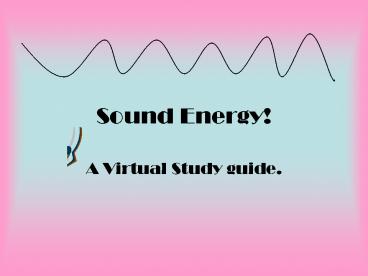Sound Energy - PowerPoint PPT Presentation
1 / 12
Title:
Sound Energy
Description:
An oscilloscope is a device that helps us to see these waves. ... Wavelength is the distance between a point on one wave to the same point on the next wave. ... – PowerPoint PPT presentation
Number of Views:422
Avg rating:3.0/5.0
Title: Sound Energy
1
Sound Energy!
- A Virtual Study guide.
2
Energy has the ability to change matter!
What is energy?
Energy moves in waves!
3
Sound Energy
- Is the ability of sound to make matter vibrate.
- Sound can change matter.
- Sound is energy!
4
Sound Energy Moves In
WAVES!
- These waves represent energy moving.
- An oscilloscope is a device that helps us to see
these waves. - Energy waves have amplitude, wavelength, and
frequency.
5
The Sound Wave
Wavelength
Amplitude
(Vibrations per second)
Frequency
6
What is wavelength?
- Wavelength is the distance between a point on one
wave to the same point on the next wave.
7
AMPLITUDE!
- The height of a sound wave shows the amplitude.
- The amplitude of the sound wave shows us how loud
the volume of a sound is.
Low amplitude
Low volume (soft sounds)
High amplitude
High volume (loud sounds)
8
Frequency
- The amount of times a sound makes matter vibrate
in one second is called the frequency. - The higher the frequency the higher the pitch of
the sound. - The lower the frequency the lower the pitch.
High Frequency
Low Frequency
9
Decibels
The unit of measurement when we measure sound.
- The human ear should not be exposed to sounds of
85 decibels or more over an extended period of
time. - Any sounds over 150 decibels could instantly
cause permanent hearing damage.
- The average speaking voice is about 60 decibels.
- A person whispers at about 20 decibels.
- A telephone rings at about 70 decibels.
10
When energy comes in contact with matter, any of
these three things could happen.
Absorbed
Reflection
Passes through
11
How sound moves through matter.
- Sound moves fastest through solids.
- The harder the solid the faster the sound moves.
- Sound travels through liquids faster than it does
through gasses, but slower than it does through
solids. - Sound travels slowest through gasses.
Put one ear on a solid and leave one ear in the
air. Notice how sound travels faster through a
solid.
12
The End!
- Remember to study your notes!
- Re-read pages D6-D22.































